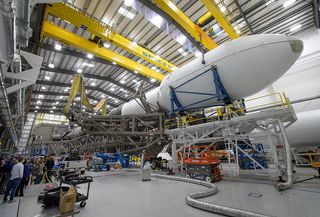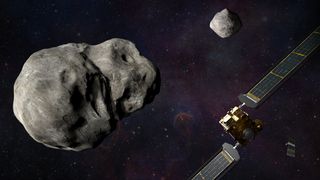SpaceX will launch NASA's DART mission to crash into an asteroid soon and you can watch it live
"What we're trying to learn is how to deflect a threat," NASA's Thomas Zurbuchen said.
Update for Nov. 24: SpaceX has successfully launched NASA's DART asteroid impact mission. You can see a video replay of the launch above. Here's what's next for the DART spacecraft now that it's in space.
NASA will launch a mission to crash into an asteroid (on purpose) overnight tonight and you can watch it lift off live online.
The agency's Double Asteroid Redirection Test (DART) mission will travel millions of miles out into the solar stem to smash into an asteroid, altering its orbit around a larger space rock to practice in the event of a rogue Earth-bound asteroid. The mission is set to lift off from Space Launch Complex-4 at Vandenberg Space Force Base in California early Wednesday, Nov. 24, at 1:20 a.m. EST (10:20 p.m. PST on Nov. 23/0620 GMT).
"It's an intentional crash of a spacecraft into a rock," Thomas Zurbuchen, NASA's associate administrator for the science mission directorate said during a pre-launch presser on Monday (Nov. 22). "What we're trying to learn is how to deflect a threat."
You can watch the launch live right here at Space.com, courtesy of NASA or directly at NASA TV. The agency's live coverage will begin at 12:30 a.m. EST (0530 GMT) on Nov. 24.
Related: NASA's DART asteroid-impact mission explained in pictures
Ready to launch
Mission teams completed launch readiness reviews on Monday (Nov. 22) ahead of the launch and "we're all go, there's no holdbacks, there's no risks going forward, and we look forward to tomorrow," Omar Baez, senior launch director at NASA's Kennedy Space Center in Florida, said during the news conference.
Get the Space.com Newsletter
Breaking space news, the latest updates on rocket launches, skywatching events and more!
Baez added that the DART team will be showing up on Monday night to begin final preparations before launch.

There is only a one-second instantaneous launch window for DART before it would be pushed to the next available launch date, Baez said, adding that the launch will take off at exactly 10:20 p.m. and two seconds local time.
However, Captain Maximillian Rush, a weather officer at Vandenberg Space Force Base, added during the briefing that while November forecasts are "quite active and more prone to fronts," and there is actually a front approaching the base, "it happens to align where it is favorable for the launch, so that's really nice for us."
So, while the weather forecast is not perfect, the team appears optimistic for the launch.
Smashing into an asteroid (on purpose)

DART will travel to a two-asteroid system that includes a small "moonlet" asteroid named Dimorphos that orbits around a larger asteroid known as Didymos, which means "twin" in Greek.
Depending on where it is in its orbit around the sun, these two space rocks could be anywhere from 6 to 306 million miles (10 to 493 million kilometers) from Earth, but right now they're roughly 300 million miles (483.6 million km) away from Earth, astrophysicist and satellite tracker Jonathan McDowell of the Harvard-Smithsonian Center for Astrophysics in Cambridge, Massachusetts told Space.com. Neither asteroid in this system poses a threat to Earth, experts have reassured.
DART's target is Dimorphos. The mission will test kinetic impact technology, a planetary defense strategy. The craft will collide almost head-on with the moonlet, pushing it and altering its orbit around Didymos. The mission aims to shorten the moonlet's orbit around Didymos by several minutes.
Mission team members on Earth will be studying the pair of space rocks using telescopes to measure the effect of DART's impact on Dimorphos' orbit.
Because the two asteroids don't pose any threat to Earth, this test won't directly make Earth safer. However, it will be critically important to proving that this type of planetary defense strategy does work. So in the future, if a rogue asteroid were to be on a trajectory that would pose a risk to Earth, NASA could theoretically use a spacecraft like DART to smash the rock away from a collision course with our planet.
While there aren't any large asteroids currently posing a risk of hurtling toward Earth, "this asteroid system is a perfect testing ground to see if intentionally crashing a spacecraft into an asteroid is an effective way to change its course, should an Earth-threatening asteroid be discovered in the future," according to a statement from Johns Hopkins University Applied Physics Laboratory, which built the spacecraft.
"At this moment in time, we don't have a single object that really is a threat to Earth," Zurbuchen told Space.com during the news conference. However, he added, with the success of this mission, "I'm really interested to see how we're going to take that technology and move forward."
Email Chelsea Gohd at cgohd@space.com or follow her on Twitter @chelsea_gohd. Follow us on Twitter @Spacedotcom and on Facebook.
Join our Space Forums to keep talking space on the latest missions, night sky and more! And if you have a news tip, correction or comment, let us know at: community@space.com.

Chelsea “Foxanne” Gohd joined Space.com in 2018 and is now a Senior Writer, writing about everything from climate change to planetary science and human spaceflight in both articles and on-camera in videos. With a degree in Public Health and biological sciences, Chelsea has written and worked for institutions including the American Museum of Natural History, Scientific American, Discover Magazine Blog, Astronomy Magazine and Live Science. When not writing, editing or filming something space-y, Chelsea "Foxanne" Gohd is writing music and performing as Foxanne, even launching a song to space in 2021 with Inspiration4. You can follow her on Twitter @chelsea_gohd and @foxannemusic.
